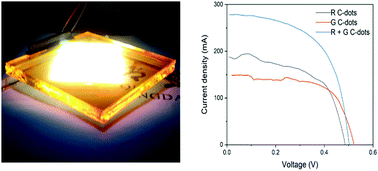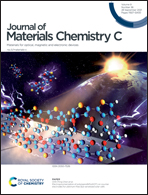Red and green-emitting biocompatible carbon quantum dots for efficient tandem luminescent solar concentrators†
Abstract
Luminescent solar concentrators (LSCs) are large-scale sunlight collectors, consisting of fluorophores embedded in waveguides, which can concentrate part of the absorbed sunlight at the borders of the slab through wave-guided photoluminescence. Benefiting from their low-cost and semi-transparency, they exhibit great potential for building integrated photovoltaics. Among various types of fluorophores, carbon quantum dots (C-dots) have attracted great interest due to their relatively high quantum yield (QY), low-cost, non-toxic composition and simple synthetic methods. Unfortunately, most red-emitting C-dots with high QYs were synthesized using relatively toxic and expensive precursors. The C-dots exhibiting red-emission synthesized using sustainable precursors (e.g. citric acid) have QYs less than 20%. Here we synthesized the red-emitting C-dots produced by using citric acid and urea as precursors and N,N-diethylformamide as the solvent via a solvothermal reaction. The red C-dots have a broad absorption from 300–650 nm, with a QY as high as 40% in ethanol. In addition, the C-dots exhibited good biocompatibility, even for a C-dot concentration up to 1000 μg mL−1. The LSC (LSC area 100 cm2) based on red C-dots exhibited a solar-to-electricity power conversion efficiency (PCE) of 1.9% under natural sunlight illumination (35 mW cm−2). We combined red-emitting C-dots with green-emitting C-dots prepared via a vacuum heating approach. By using a tandem structure, composed of two slabs each incorporating a different C-dot type, the obtained PCE of the LSC based on the combination of red and green C-dots further increases up to 2.3% (under the same irradiance equal to 35 mW cm−2), which is comparable to the reported PCEs for the LSCs based on C-dots or other types of fluorophores. This work indicates that the red-emitting C-dots produced by low-cost and environmentally-friendly precursors exhibit great potential as building blocks for the environmentally compatible LSCs.



 Please wait while we load your content...
Please wait while we load your content...